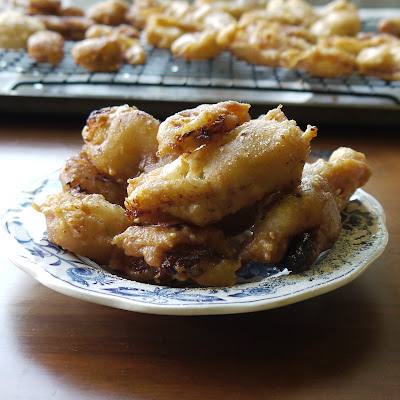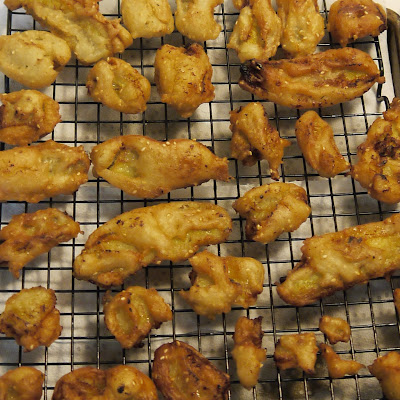The Setting: An apartment in need of a good cleaning, a bit of last-minute packing, and some mouths to help eat all the ice-cream that remains in our freezer!
The Soundtrack: The Lion King.
Steaming up the Oven: Nothing now, but the promise of chipotle-gazed shrimp is on the horizon.
The Scenario: As Hoosband and I prepare to depart for Dallas and then Fairfax this summer, the journey down the Mekong with Hot Sour Salty Sweet comes to an end, like any good meal, with dessert.
It's been a pretty ridiculous month or two.
Oia turned nine-months old in April (which I'm still trying to wrap my head around), so she is busy discovering her world, increasing her hand-and-knee mph, and becoming increasingly harder to keep up with--I know, it's just the beginning.
Work on the cookbook has been keeping Hoosband and I well-padded, well beyond winter.
Preparing for three moves (and many long car rides) this summer has had us packing, cleaning, organizing, and agonizing.
And Hot Sour Salty Sweet has been indulging our adventurous sides in the kitchen and on the blog.
Like any worthy adventure, the journey down the Mekong with Alford and Duguid has had its ups and its downs: Vietnamese Chicken Salad will be a new staple in our household; homemade rice noodles will not.
However, the very best adventures always end on a high note, or at least a redemptive one, and I'm pleased to report the conclusion to our culinary journey through Southeast Asia is both.
Not only did I manage to actually track down every ingredient in the recipe and successfully execute the instructions--yes mom (and Hoosband, and teachers throughout the years), it's possible--but the resulting crispy puffs of deep-fried deliciousness were, well, delicious.
I am a lifelong connoisseur of both bananas and all-things fried, but these Thai treasures were surprisingly scrumptious, even to me. I think it's the roasted sesame seeds in the batter that send this dessert from "hey, not bad" to "betcha can't eat just three."
Try the recipe for yourself and let me know what you think--I'd love your feedback.
And if you like what you've seen here, remember to check out Hot Sour Salty Sweet for more of Alford and Duguid's mouthwatering memories from the Mekong.
I know I'll be planning my return trip soon!
The following recipes are reprinted with permission from Artisan Books; my notes are in red.
Fried Bananas (gluay khaek--Thailand)
1/3 cup all-purpose flour
1/2 cup rice flour, or more if needed
1/2 tsp baking powder
2 T sugar
1/2 tsp salt
1/2 cup water or canned or fresh coconut milk I used the kind in the carton from Silk.
1 T Dry-Roasted Sesame Seeds (page 308 see below) (optional)
4 to 5 firm ripe bananas I had just enough batter for 4 large bananas
Peanut oil for deep-frying
In a large bowl, mix together the flours, baking powder, sugar, and salt. Add the water or coconut milk little by little, stirring until a smooth batter forms. The batter should be a smooth paste, not watery; add a little extra rice flour if it seems thin. Stir in the sesame seeds, if using. Let stand for 10 minutes.
Peel the bananas. Cut crosswise in half, then slice each lengthwise into 3 slices.
Place a heavy pot or stable large wok over high heat. Add oil to a depth of about 1 1/2 inches (in the deepest part of the wok) and heat until the oil just starts to smoke. I personally do not recommend letting the oil smoke, but it should start to sort of shimmer and almost ripple. To test for temperature, add a blob of batter to the oil: It should sink and then rise back up immediately, without turning black. If it blackens quickly, the oil is too hot and you should reduce the heat to medium-high. If it doesn't rise back up to the surface, the oil is not yet hot enough; wait another minute or two before testing again. Place a paper towel-lined plate by your cooking surface. I like to place a cooling rack on top of a paper towel-lined baking sheet.
When the oil is at the right temperature, place a banana piece in the batter and turn to coat it, then slip it in the hot oil. Repeat with a second piece of banana. If the banana is very ripe and a little soft, the pieces may break up into two smaller pieces; don't worry, it doesn't matter. Most of mine broke; they were no less delicious. Deep-fry, turning them over halfway through cooking, until golden brown, 1 to 2 minutes, depending on the size of your pot. Remove with a slotted spoon, pausing to allow excess oil to drain off, and place on the paper towel-lined plate. Repeat with the remaining bananas. Transfer the cooked bananas to a plate and cover or place in a 150 degree F oven to keep warm. Serve hot. I couldn't resist sifting a little powdered sugar over the tops of the fried bananas, not that it is at all necessary. Also, while they are best served hot, I found them equally as addictive at room temperature and even straight out of the fridge the next morning with a hot cup of coffee.
Makes 24 to 30 pieces; serves 4 to 8, depending on the size of your bananas.
Note: Vietnamese restaurants often serve a colonial fusion version of this, called bananes flambees. Long slices of banana are pressed flat, dipped in batter, and fried. Just before they go to the table, they're dusted with sugar and then a liqueur or high-alcohol rum is poured over and set alight. The bananas arrive glowing with quiet blue flames.
Excerpted from Hot Sour Salty Sweet by Jeffrey Alford & Naomi Duguid (Artisan Books). Copyright 2000.
Dry-Roasted Sesame Seeds
Like peanuts, these contain a lot of oil, so they can burn very quickly. Place a heavy skillet over medium-high heat and add about 1/2 cup sesame seeds (or whatever quantity you wish to roast). Use a wooden spoon to stir them continuously and keep them from burning. Once they are golden and aromatic, lower the heat slightly and continue to stir and turn until they are a rich golden brown. Transfer to a bowl and stir several times as they cool to help the steam escape. When they are completely cool and dry, store in a sealed glass container in a cool place.
If you want to crush or grind roasted sesame seeds, use a spice grinder or a mortar and pestle. The Japanese mortar known as a suribachi has ridges inside its bowl, ideal for grinding sesame seeds.
Excerpted from Hot Sour Salty Sweet by Jeffrey Alford & Naomi Duguid
(Artisan Books). Copyright 2000.
Thanks for reading! Here's to Being the Secret Ingredient in your life.

.JPG)
.JPG)




.JPG)





yes.JPG)

.JPG)
+(798x800).jpg)
No comments:
Post a Comment